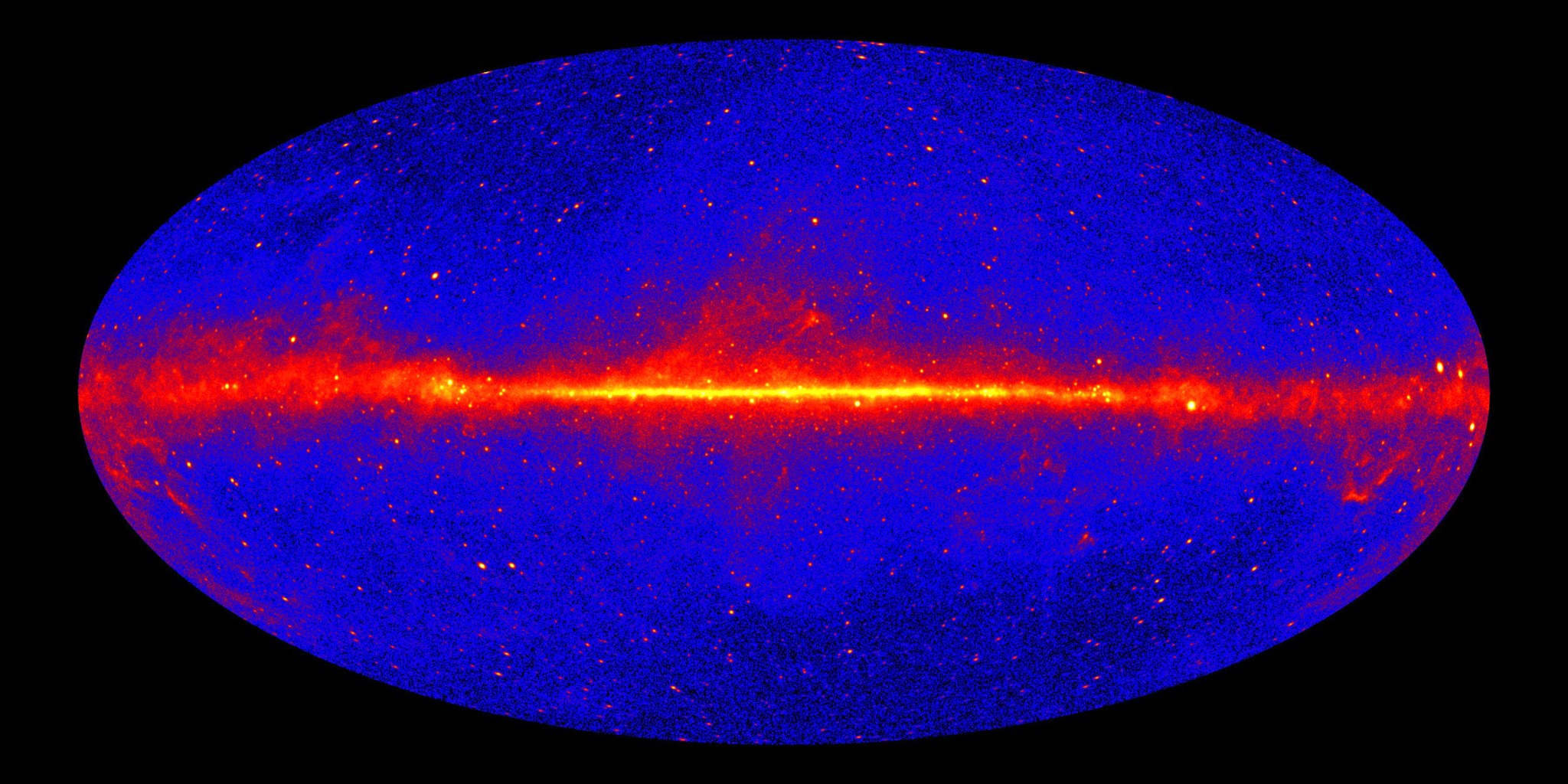This article is for students grades 5-8.
The Fermi Gamma-ray Space Telescope is a NASA spacecraft. It is in space studying the most powerful sources of radiation in the universe. Radiation is energy that is in the form of light or of moving particles that are smaller than atoms. The most extreme type of radiation is gamma rays.
____________________________________________________________________________________________
Words to Know
wavelength: the distance from the peak of a wave to the peak of the wave beside it
radio waves: the type of electromagnetic radiation that has the longest wavelengths and the lowest energy, and carries radio, TV and cell phone signals. Radio waves may be as long as a football field or as short as a football.
microwaves: the type of electromagnetic radiation that has a wavelength between 1 millimeter and 30 centimeters. Microwave energy can be used to heat food, as in a microwave oven.
infrared radiation: the type of radiation that has wavelengths longer than the red end of visible light, but shorter than microwaves, with wavelengths between 1 and 100 micrometers. Infrared radiation is felt in the heat of the sun. These waves are also used in TV remote controls.
visible light: radiation that human eyes can see. People see the longest wavelengths, which are about 700 nanometers, as the color red. The order of the remaining colors from longest to shortest wavelengths is orange, yellow, green, blue, indigo and violet. Violet has the shortest wavelength of about 400 nanometers.
ultraviolet radiation: the type of radiation that is shorter than the violet light that humans can see. This type of radiation can cause sunburn.
x-rays: the type of radiation that has high energy and can be used by doctors to see bones inside the body.
gamma rays: the type of radiation that has the shortest wavelength and the highest energy. Some radioactive materials give off gamma rays.
____________________________________________________________________________________________
What Are Gamma Rays?
Light energy comes in many different forms. People can only see a small portion of the different types of light. This light is part of the electromagnetic spectrum. This spectrum is made up of all the types of electromagnetic, or EM, radiation in the world and possibly in the universe. EM radiation travels in waves, and each type has a different wavelength.
Visible light, which is the light that people can see, has medium-length waves. Radio waves have the longest wavelengths. Microwaves and infrared light waves also are longer than visible light waves. Ultraviolet (or “UV”) rays, X-rays and gamma rays all have wavelengths that are shorter than visible light. The shorter the wavelength, the more energy the radiation has. Gamma rays have the shortest wavelengths; therefore they have the most energy.
Gamma rays have more than 1 billion times the energy of visible light. Gamma rays have so much energy they could harm people on Earth. People are protected from gamma rays by Earth’s atmosphere. The atmosphere absorbs gamma rays, preventing them from affecting life on Earth. Because gamma rays cannot penetrate Earth’s atmosphere, scientists use satellites in space to study them.
Why Is NASA Studying Gamma Rays?
Gamma rays come from the most extreme places in the universe. NASA is studying them because scientists want to learn more about the high-energy environments in the universe that make gamma rays. Gamma rays often come from objects like black holes and exploding stars.
Gamma rays sent out by objects embedded inside galaxies greatly affect the space around these objects and how these galaxies evolve. By studying gamma rays, NASA can better understand how the laws of physics work in the extreme environments found in the distant universe.
How Does Fermi Work?
The Fermi telescope has two main instruments. It has a large telescope that finds gamma rays with 10 million to more than 300 billion times the energy of visible light.
The spacecraft also has detectors that observe gamma-ray bursts. Gamma-ray bursts are brief flashes of gamma rays. Scientists think most of these bursts come from exploding stars that become black holes as their cores collapse.
More than half of the known gamma-ray sources are mysterious. Scientists do not know what causes the gamma rays to be emitted from these sources.
The information from Fermi is sent back to scientists on Earth. The scientists use the data to create pictures of the objects Fermi studies. These pictures help scientists discover the sources of gamma rays.
What Is NASA Learning From Fermi?
Fermi was launched June 11, 2008. Scientists hope to use the telescope to observe the high-energy universe until 2018. Fermi was first named GLAST. GLAST stood for Gamma-ray Large Area Space Telescope. After GLAST was launched and started its work, it was renamed after scientist Enrico Fermi.
Enrico Fermi studied physics, which is the science of matter, forces, energy and motion. Scientists who study physics are called physicists. Enrico Fermi studied high-energy physics including gamma rays. The Fermi telescope is helping NASA learn more about Enrico Fermi’s theories.
With the Fermi telescope NASA is making discoveries almost every day. Fermi is discovering new supermassive black holes. These are the largest type of black holes.
Fermi is also finding new pulsars. Pulsars are collapsed stars that emit repeated pulses of energy. Fermi finds pulsars that can only be found by measuring gamma rays.
Fermi’s most exciting discoveries are yet to come.
More About the Fermi Gamma-ray Space Telescope
Fermi Gamma-ray Space Telescope
What Is a Black Hole?
GLAST (Fermi) Music Video
See Where Fermi Is Flying
Read What Is the Fermi Gamma-ray Space Telescope? (Grades K-4)






























